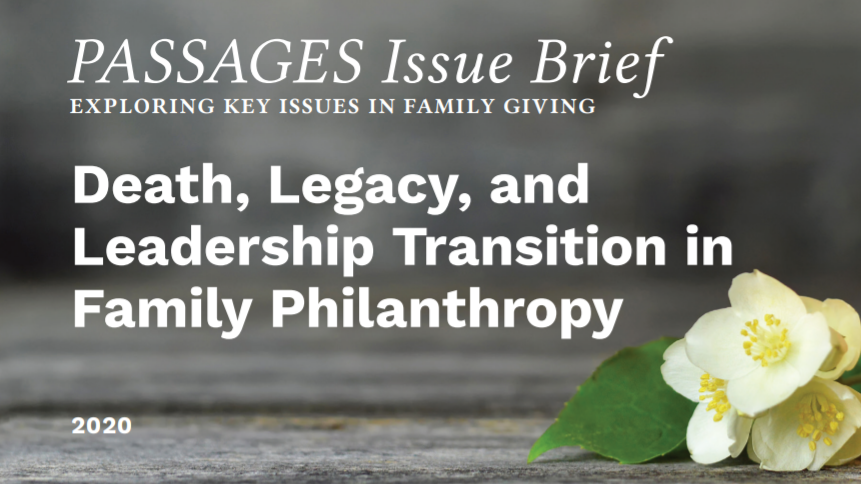Money and Death: Having the ‘What Happens When’ Conversation

The death of a foundation leader or senior family member is likely the most emotional change a foundation will undergo. Suddenly, or not so suddenly, family members and the board face grief and loss, perhaps alongside an onslaught of financial, legal, and organizational issues. How can you plan ahead, as a foundation and as a family? And how can you honor your late leader’s legacy while moving the foundation forward?
The following is excerpted from NCFP’s new Passages Issue Brief, Death, Legacy, and Leadership Transition in Family Philanthropy, which shares stories and advice from family foundations who have grappled with deep loss, managed a rapid change in leadership, and learned to move on in a way that best served the family and the foundation.
Money and Death: Elusive Topics
While many donors establish family foundations and donor-advised funds, fewer have open conversations with their kids about money. This can leave a big surprise for the second generation if a parent’s death creates a significant influx of assets to the foundation or fund.
This is what happened to the Satterberg Foundation in Seattle. Family members expected there would be a sizeable increase to the Foundation when their father William Helsell passed away in 2012, but were surprised to find out how large the bequest was. According to board and family member Mary Pigott, “Dad never shared the details with us, and we thought we would grow to around $100 million at most. Over a period of 12-18 months after Dad died, assets started to trickle into the Foundation to the tune of $400 million. We had no idea it was coming.” The Foundation, she says, was left reeling in the process.
In another family, a father left $100 million of his estate to a new private foundation—one the rest of the family had never heard of. “This is a case study in what not to do,” says his granddaughter. “I believe the founder, my grandfather, received bad advice from his estate planner. He had a complicated estate, and likely set up the foundation as a placeholder, something to figure out later.” This surprise foundation created a huge feud between brother and sister in how to manage it—a rift from which they never recovered.
Keeping future generations in the dark “can cause tremendous pressure and discord among members of the family,” says Mary Phillips of GMA Foundations, a Boston-based philanthropic advisory firm. “I tell donors: you must tell your children what you are leaving them and what you are not. If your foundation will get much larger, your children need to know that. They need to prepare,” she says.
When donors stay silent about money and legacy, it can be a lost opportunity for a sense of shared purpose within the philanthropy. “What donors regret most at the end of life is if there was not a lot of time doing the philanthropy together, or telling the children why they wanted them involved or what they wanted for the foundation,” says Ginny Esposito, senior fellow at National Center for Family Philanthropy (NCFP). “It leaves younger people wondering: what would Mom or Dad have wanted?”
She recalls a donor who was proud of his family, and had written a donor legacy statement, unbeknownst to the kids. “I suggested to him: ‘wouldn’t it be more fun if you invited the kids into the conversation?’ And he did! He passed away a few years later. What if all that family pride had not been shared with his loved ones while he was living?”
“Not many people want to talk about money or their own death. People avoid the issue entirely; they don’t want to create issues or have to answer questions. Yet that’s not helpful to the people left behind,” says Phillips. “If donors are reluctant to talk about their death and legacy, I ask them: ‘what will happen to your foundation if someday in the future there are no family members to manage it?’ That’s usually an eye-opening moment where they realize they should be thinking about this question.”
Another way to approach the conversation might be to ask: ‘how do you want the next chair to lead the family and board?’ “This can give the founder a feeling of control in spite of the sensitive topic,” says Suzanne Hammer of Hammer & Associates, a Denver-based national philanthropic advisory firm.
Hammer says she has worked with many family leaders, even those advanced in age, who refuse to talk about their own death, or the pending death of family members. “Some aren’t willing to let go and are determined to remain in control. Others are more in denial, or simply too scared (or stubborn) to consider what life may be like when they’re gone.”
When one person is in death denial, it can disrupt the entire family system—and the potential for a planned succession. “A family can’t move forward on succession planning if members don’t engage in open conversations about the future. Open, honest conversations enhance the leadership potential for the next generation, and ensure a clear passing of family legacy,” she says.
Until an individual or family member is ready to accept the reality of death or talk about it openly, there’s not much family or staff can (or should) do to convince them otherwise, she says. “What you can do is ask them questions, give them space to talk about it, present different future-focused scenarios, and what those situations will result in—for example, the tax or leadership implications,” she says.
In other words, keep the conversation on the practical side, and it may be more productive.
Death, Legacy, and Leadership Transition: Preparedness Quiz
How prepared is your family philanthropy for the death or illness of a donor or senior leader? While it may be impossible to be fully ready for the loss of any leader or loved one, there are steps you can take to plan ahead, making it much easier should a crisis occur. Take this two-minute quiz to find out how prepared your family philanthropy is, and in what areas you might improve.
Having the ‘What Happens When’ Conversation

In a family philanthropy setting, it may be up to a brave family member or one lead staff member to get a conversation started around death and succession. This can be a delicate situation, particularly if you play the dual-role of family member and staff. Here are some tips that will help both family and non-family staff prepare.
Be clear on roles and expectations. What is the purpose of the conversation? Who should be in the room for it (and who gets to decide)? What is the role of the board chair, senior members of the family, and the next generation in the conversation?
Set boundaries for the extent of your involvement. What is your role as a family member who staffs the foundation? Or as non-family staff? How can you best help the family overall? If you are non-family staff, be clear this is the family’s work, and encourage the family to address it. It helps to serve as a guide, give them options within the conversation, and offer your honest opinion, but they must be the ones to make these decisions.
Bring in an outside facilitator when needed. If you are a family staff member, anticipate that it might be challenging to guide your family members through such an emotional conversation. It can be a productive and worthwhile investment to bring in a neutral philanthropy advisor skilled in holding these conversations around legacy and succession.
Plan for foundation effectiveness over family desires. A succession plan needs to work for both the family and the foundation. One at the expense of another will not work for anyone. Make sure whatever solution the family comes up with works for the foundation. Remind the family there are many people outside the board room who are waiting for the foundation to make good decisions.
Gauge the family’s comfort level. You know the family’s nuances and personalities. Rely on your own emotional intelligence in deciding the right time to broach the topic, and think about the language you use. The family might not be ready to talk about death or succession, but if they are in business, they might find it fine to talk about “contingency plans.” Meet the family where they are at, and guide the conversation toward the goals at hand.
Strengthen the board. A strong governance structure gets you where you want to go, and builds the future leadership of the foundation. When a board has clear policies in place on board eligibility, nominations, terms, and expectations, it can make the succession conversation much more straightforward—less about personalities, more about principles.
For more tips, stories, and advice from your peers on this difficult topic, read Death, Legacy, and Leadership Transition in Family Philanthropy.
The views and opinions expressed in individual blog posts are those of the author(s) and do not necessarily reflect the official policy or position of the National Center for Family Philanthropy.
